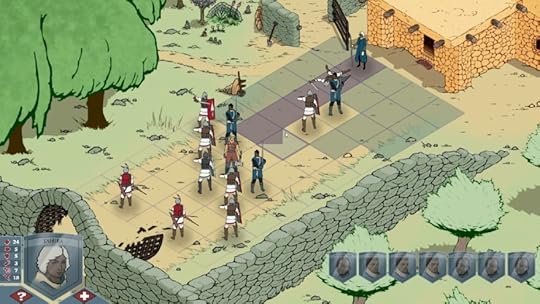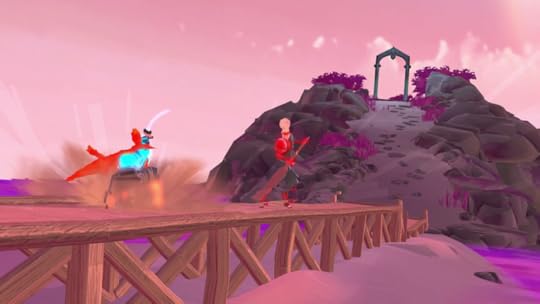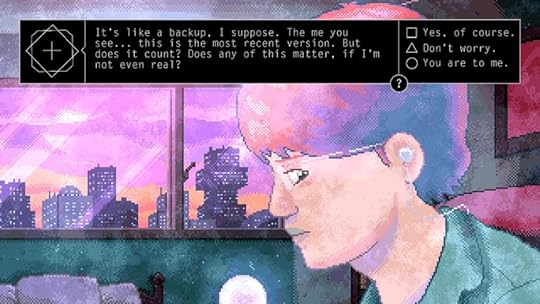Kill Screen Magazine's Blog, page 89
July 19, 2016
Valkyria Chronicles is a different kind of war story
We tell a lot of stories about war. The appeal is, in one sense, straightforward: war checks off nearly every box in the dramatist’s playbook, replete with high stakes, clear protagonists and antagonists, and themes of heroism and loss. But the pendulum swings the other way, as well: wars don’t just make for good stories, good stories also help us cope with war. In order to wrap our minds around these big, bloody catastrophes, fraught as they are with inscrutable ideological and economic motivations, we construct simple narratives to bring coherence to the incoherent. Videogames hold a particularly vested interest in reducing the complexity of war. They ask the player to take an active role in the carnage and so must take pains to make her actions feel justified, nestled into the digestible conceit that war may be hell, but someone’s gotta do it. Without a clear us-versus-them story behind it, a war game becomes not only uncomfortable to play, but can provoke a deeper anxiety about the morality of killing in the name of god and country—the very anxiety war stories are intended to reduce.
Sometimes a conflict is so confusing that attempts at creating a straightforward narrative strain credibility. In his essay Beyond the Pleasure Principle (1920), Sigmund Freud introduced the bizarre notion of a “death drive,” an innate human compulsion toward oblivion that rivals our desire to experience pleasure. Even at the time, Freudian psychoanalysts struggled to accept or even understand the bold assertion that people unconsciously crave their own demise. But for Freud—who had always been interested in the universal properties of the psyche—there was no other way to account for what he had seen out his Viennese window for the past several years, as the entire European continent seemed determined to burn itself to the ground during the First World War. Historians and artists still struggle to paint a clear picture of WWI, which may be why we see relatively few modern artworks exploring the subject. The lack of an agreed-upon narrative can be particularly thorny for videogames; clear disambiguation of sides is needed if the player is to feel like a hero and not a monster when lobbing grenades into a crowded trench. Notably, Electronic Arts has chosen to set their upcoming Battlefield 1 during the First World War, though some have questioned the wisdom of this choice for precisely the reason that WWI remains a muddled and morally ambiguous event in the annals of time.
US Navy, photo uploaded by Dna-webmaster
The European campaign of World War II was more easily funneled into a binary narrative of good versus evil that has held up well for the past 70 years. There is a reason, for instance, that the Call of Duty series has featured no titles set during WWI but four during WWII. The unprecedented human atrocities committed by Nazi soldiers and the megalomaniacal personality of Adolf Hitler laid the groundwork for an unambiguous tale of heroes and villains. But as in all war narratives, a few frayed threads were left dangling in the aftermath. As I have discussed elsewhere, the principal concern to emerge from WWII in the United States was in reconciling the evilness of Nazism with the universal qualities of human nature promulgated by Freud’s psychoanalysis. If German citizens were people like the rest of us, how is it so many of them were led down such a dark path? Does that mean that we, too, have such darkness lurking within? The issue of accountability became paramount; those with the capacity to do evil had to be distinguished from those who do evil. As Americans, we weren’t only trying to figure out what made us different from Nazis. We were nervously trying to pardon ourselves for how we had ended the other half of the war in Japan. Yes, someone dropped those bombs. Yes, they fly the same flag as me. No, they are not me.
Humanism was a psychological perspective born out of this post-WWII anxiety. It challenged psychoanalytic assertions of universality by focusing not on the species but the individual: every person is unique, derives her own sense of meaning out of life, and is responsible for her own choices. In contrast to the deterministic aspects of Freudian psychoanalysis—which held that people are bound to enact unconscious desires, whether toward pleasure or self-destruction—humanists emphasized notions of freedom and personal responsibility. But despite emerging as an attempt to understand and even prevent the rise of fascist power, humanism did little to shift our specific narratives about WWII. In our minds, it is still a simple story of good and evil.
///
Valkyria Chronicles (2008/2016) is, like so many others, a game about WWII—but with a few tweaks. Imagine the story as you know it, but this time both the Axis and the Allies are self-interested conquerors; the real heroes are the neutral Swiss; Jews are hated for their dark hair and alleged warlock powers (that one adheres distressingly close to history); and the entire war is actually about securing a natural resource called ragnite, which can do everything from heal the sick to power tanks. Oh, and pure-blooded Aryans shoot energy bolts out of massive stone lances. Historical accuracy is not the game’s objective. All names have been replaced with fantastical alternatives: Europe is “Europa”; Switzerland “Gallia”; Nazis “The Empire”; Jews “Darcsens”; Aryans “Valkyrians.” But these cosmetic alterations should not obscure the astonishing aim of Valkyria Chronicles, a contemporary Japanese game about the European campaign of our species’ most documented global conflict that attempts to turn the traditional narrative of that conflict on its head. Specifically, it reconstructs the WWII story through the lens of humanism.
In our minds it is still a simple story of good and evil
The plot of Valkyria Chronicles follows Welkin Gunther and his ragtag militia as they move from auxiliaries to crucial linchpin in the war against the Empire. The game takes place in Gallia, Welkin’s home country, which is rich in ragnite but neutral in the colonial pursuits of the eastern Empire and western Federation that surround Gallia’s borders. The obvious historical correlate is Switzerland, whose declared neutrality during WWII is typically viewed through modern eyes as shameful; by doing nothing when one side was so clearly more hateful and destructive than the other seems tantamount to, at best, ignoring reality for the purpose of self-protection, and at worst a tacit approval. In Europa, however, objective morals are replaced by an ethics of individuality. Gallia’s lack of political ambition is repeatedly contrasted with the crass and dehumanizing acts of mainstream Europa on either side: The Empire is most deplorable for its military blitzes and Darcsen concentration camps, but even the Federation stoops to kidnapping Gallia’s princess in the hopes of using her as a bargaining chip. While the rest of the world tries to force its will on others, Gallia is heroic because it is only interested in being itself.
Welkin, notably, is not a career soldier; like the rest of the team he commands (simply named Squad 7), he is a private citizen conscripted into service at the outbreak of the Second Europan War. Despite the tactical brilliance he demonstrates over the course of the game, Welkin is actually as un-soldierly as they come: he is a naturalist, fascinated with how disparate flora and fauna can coexist in flourishing ecosystems. More than once he steps from the heat of his ragnite-powered tank to comment on a patch of flowers, not only for its beauty but its resilience in the face of surrounding death. He urges his teammates to keep the sanctity and specialness of life in mind, even as they prove increasingly adroit at shredding their way through Imperial detachments.
Gallia is not portrayed as a unified front of do-gooders, however. The royal army takes every opportunity to make the drafted militia feel small, and even more there are early tensions within Squad 7 itself. Some are pacifists, some embattled soldiers who served in the First Europan War; some hate Darcsens, some are Darcsens. The bulk of these differing perspectives are played out in the game’s main story among a few central characters, but the humanistic notion that every person is unique is driven far deeper into Valkyria Chronicles, from its side-plots to some of its basic play mechanics.
Though the plot plays out in a linear fashion, delving into what makes each major character tick—that is, what makes them unique—is often left to the discretion of the player. Some cinematics are optional; the player may choose to view them or not, knowing that the only benefit of doing so would be understanding the motivations of both Gallians and Imperials a little better. Irene Ellet, Squad 7’s embedded journalist, periodically offers bonus levels for sale which focus on fleshing out a given character’s personal journey. The optional content makes the player volitional, rather than someone simply compelled into a fatalistic march toward the game’s conclusion. If you want to know the full story, if you want to know who these people really are, that is your decision—the game will not make it for you.
A conventional war narrative might similarly flesh out the main characters of its central plotline, but Valkyria Chronicles also wants to remind you that every soldier, no matter how small their role, is a singular human being. Anyone that you put on the battlefield, as well as anyone you leave behind on the bench, has a name, a backstory, a handful of best friends, and specific personality quirks—everything from “Pollen Allergy” to “Fancies Women,” which serve to buff or debuff as appropriate during battle. Unlike other squad-based titles like XCOM: Enemy Unknown (2012) or this year’s Darkest Dungeon, which allow you to rename and modify incoming characters to suit your godlike whims, Squad 7 is preset. They are who they are, it’s up to you to get to know them and figure out how this group of individuals can best work together.
Players are asked to be more tactically granular than other class-based games by appreciating that not all scouts or snipers or shocktroopers are alike: one may prefer the solidness of a paved road while another feels more herself with grass under her feet; for one, a hail of bullets triggers a surge of adrenaline, while another would rather defend the base than charge into the fray. All characters receive stat boosts if they are physically close to their friends (unless they have the “Lone Wolf” quality, in which case they have no friends), who are culled from the master roster.
Every soldier no matter how small their role is a singular human being
In the end, it must be said, the great attention paid to uniqueness often does not pay off on a tactical level. In my two playthroughs of the game (once in 2008 on the PS3, once this year on the remastered PS4 version) I rarely felt the idiosyncrasies of my team made the difference between failure and success, or even varying degrees of success, on any given mission. I still have my favorite squaddies, however, and that may be the more important point. Though Valkyria Chronicles seems to encourage you to assemble a team based on a complex statistical analysis of how personality and friendship bonuses will stack with one another, what you mostly end up doing is building a community of people you like.
I always bring Nadine the engineer with me, because I like having at least one Darcsen around. When a mission calls for sniper support, I invariably choose Marina, even though some of her quirks make her unreliable, because she just seems cooler than the other snipers. I refuse to enlist the lancer Nils as one of his traits is “Misogynist.” Each soldier has her own potential micro-story, which will reveal itself or not depending on how you play. When my beloved scout Juno died during a brutal skirmish, she cried out her secret affection for Welkin before collapsing. This had no bearing on the main plot, it was only meant as a window into Juno’s small, tragic story—one that I was responsible for telling, firstly, by choosing to enlist Juno, and secondly by putting her in harm’s way. Being imbued with individuality that does not especially translate into strategy transforms the characters into more than tools of battle; they become people.
///
Anisimov, Aleksandr (2002) Kiev and Kievans, Kurch
That Valkyria Chronicles is a successful humanistic reimagining of WWII creates a conundrum. Do we want the traditional narrative of this war to be questioned? There is value, surely, in maintaining Hitler as an emblem of evil within our cultural consciousness, in dehumanizing Nazis as they dehumanized millions of others. But Valkyria Chronicles maintains that missing the individual for the group can be a slippery slope, one that runs all the way to our planet’s hellish, molten core. In a scene toward the end of the game, a Valkyria named Selvaria—who fights for, and is in love with, the invading Emperor Maximilian—sacrifices herself in order to wipe out Gallia’s central army. Though the source of the blast is fantastical Valkyrian magic, the result looks a lot like a mushroom cloud. This is Valkyria Chronicles’ only allusion to that other WWII campaign, the one that ended in two bright flashes of radiated light, the one that snuffed out over 100,000 Japanese lives instantaneously.
If dehumanization is a means to wage war, simplification is a means to rationalize it. And doing so cuts both ways: whether every Jew is a rodent or every German a monster, it makes them easy to kill and it makes their killing easy to justify. Valkyria Chronicles reminds us that a reliance on simple narratives makes us beholden to the narrator, who is typically the victor. The Valkyrians, it turns out, were savage conquerors who struck such a blow against the native Darcsen population in ancient times that they were able to rewrite history and paint themselves as saviors. The player moves through Valkyria Chronicles as though it were a history book, but one that is trying not to gloss over ugliness or paint with a broad brush; a counterexample to the Valkyrians’ whitewashing. The allowance of complexity and humanity into our tales of war is offered as a means of avoiding reductionist explanations that can persist for generations and lead to future carnage.
If dehumanization is a means to wage war simplification is a means to rationalize it
The game does not take the naive stance that by avoiding simplified stories we can avoid killing altogether. Welkin, the nature-loving pacifist, leads Squad 7 to victory after victory, and can in turn receive medals from Gallia’s princess for killing 250, 500, and 1,000 Imperial soldiers. But by walking us through a familiar story with a novel focus on individuality and choice, Valkyria Chronicles sets itself apart as a war game more interested in cultivating human bonds than putting bullets in enemies’ heads.
The post Valkyria Chronicles is a different kind of war story appeared first on Kill Screen.
July 18, 2016
Tahira, a sci-fi epic that will question our violent histories this August
Before the imperialism of the 19th century, or the World Wars of the 20th, there were the Crusades: a series of military campaigns in the Middle-East between the 11th and 15th centuries. During these campaigns, various Christian European powers sent large numbers of well-equipped men to what was dubbed the Holy Land to fight against local inhabitants, as well as the largely Muslim Turks, who would eventually become the Ottoman Empire. They were fought for a number of reasons: to capture Jerusalem, to help the Byzantine Empire maintain control of its lands, arguably to attempt to reunite Eastern Christians with their Western counterparts, and at least publicly to combat what was labeled as paganism and heresy.
They’ve been covered in games before, notably in the Assassin’s Creed series, which highlights corruption among the invading European forces and the oppression they inflicted on the native people (especially those of Jewish descent) of the cities and regions they claimed. The violence lasted on and off for roughly 400 years, and though it did help lead to the Renaissance through the various treasures and knowledge pillaged by the Europeans, it ultimately resulted in very little territory being established in exchange for the bloodshed that paid for it, and is generally not remembered well by historians, who argue that faith alone did not justify the slaughter.
Tahira: Echoes of the Astral Empire is an upcoming tactics game that isn’t about the Crusades directly, but the influence is clear. Inspired by the writer’s time spent in nations like Turkey, Syria, Jordan, and Israel, the game places the player in control of Tahira, the last heir of a small kingdom that is on the verge of invasion from the “genocidal Astral Empire.” While the architecture and fashion of Tahira’s people are influenced by the history of the locales visited by the writer—loose-fitting robes and turbans, etc—the Astral Empire is clad in gear more resembling medieval European armies, such as red-and-white plate armor, crosses, and massive shields. The imagery is there, if a bit stereotypical, but more important is the message: this is an invasion from an outside force bent on either absorbing another culture into its ideology entirely, or killing it in the process.
The twist, then, comes in this world’s backstory. First, Tahira does not take place on Earth. Rather, it is set on an old colony world from a long-forgotten human spacefaring empire, where the descendants of the explorers have let their heritage fall into legend and have reverted to a more medieval way of life. However, the planet was only ever partially terraformed, and the more they stay put, the more inhospitable it gets. Hence the Astral Empire and its crusade to take over and “unify” the planet towards returning to the stars before it’s too late.
an old colony world from a long-forgotten human spacefaring empire
The problem arises in their methods, which involves slaughtering any who would oppose them or refuse to be subsumed into their whole. Still, the difference between the historical crusades and the Astral Empire raises an interesting question: can a crusade ever be justified? While the crusades in our world were often predicated on flimsy excuses, the one in Tahira is made in the name of survival. If the people of this world do not leave the planet before it is too late, they will die. At the same time, though, is survival worth it if those who remain have to sacrifice their integrity to get there? Can they live with themselves afterwards?
It’s the type of question raised by stories like Ursula K. Le Guin’s The Ones Who Walk Away from Omelas (1973), in which a utopian city is only able to prosper due to the perpetual torture of a single miserable child. When citizens of the city learn about this, they have to choose whether to live with that fact and accept the city’s bounty, or to maintain their integrity and leave for a more uncertain future. Similarly, Tahira confronts the audience with whether the Astral Empire’s goals justify their crimes, or whether a society that commits such crimes even deserves to survive in the first place. Maybe, in this scenario, the needs of the many do not outweigh the needs of the few.
As Tahira herself, the player must both decide where they stand on these larger issues while still leading their homeland’s armies to defend her people from the Astral Empire’s more immediate invasions. This is done through turn-based tactical battles similar to Nintendo’s Fire Emblem series, each of which also feature detailed rotoscoped—essentially the 2D version of motion capture—battle animations. At the same time, the game’s story will unfold through choice-based cutscenes and dialogue menus, similar to BioWare’s Mass Effect series or Telltale’s The Walking Dead. And like these series, choices made early on are promised to make important changes in how the story progresses.
The game is set to take course episodically, with the script already written for two seasons of a couple episodes each. If that sounds exciting to you, then you’ll be glad to know that after a successful Kickstarter campaign in February of 2015, the wait for the first episode is almost over. On July 12th, the game’s team released a Kickstarter update with two new pieces of information. The first was a new trailer for the game, largely showing off plot details that had already been revealed by the initial Kickstarter trailer, but this time with new rotoscoped animation. The second was a release date: August 31st. Meaning that, for all you would-be leaders out there, it won’t be long until you take command. Just remember that with command, also comes the burden of deciding who lives, and who dies.
You can find out more about Tahira: Echoes of the Astral Empire on its website.
The post Tahira, a sci-fi epic that will question our violent histories this August appeared first on Kill Screen.
The First Tree looks foxy (and tragic) in its first trailer
The last time that we talked to David Wehle about his upcoming game The First Tree, it wasn’t much more than a few screenshots of a fox and his earnest desire to tell a story about the nature of life and death. It aims to weave two stories together—a fox searching for her lost kits and a human couple undergoing a tragedy—to bring beauty and meaning to the exploration genre. The recently-released teaser trailer shows just how poignant these tales can be.
It follows the familiar fox through a forest as a young man and woman talk about dreams. She jumps through snowbanks and off rocks into rivers, collecting little silver stars, digging at piles of dirt, and scaring crows away from another fox, laying immobile on the ground. Her lost child?
“What did she do?” the woman asks the man.
“She ran.”
just as personal and devastating
And run she does, through the forests and the mountains and the early dawn. Wehle is building off of previous experiments to grow and develop the exploration genre—his earlier game Home Is Where One Starts… (2015) was about a child growing up in a broken home in the American South—and The First Tree looks to be just as personal and devastating. The fox’s tale illustrates the human story, but the emphasis is on the parallels between the two, not the differences. “She found something,” the narrator says of the fox. “Maybe I need to find it too.”
Wehle is developing The First Tree by himself—and around his day job as an artist for VR—and notes that while Home Is Where One Starts… took him almost two years to create, this next game of his might be less as it’s now been scheduled for a 2017 release. He’s also expressed interest in expanding to consoles based on player interest, and will be announcing more details soon.
Follow David Wehle on Twitter and sign up for The First Tree’s email list on the website .
The post The First Tree looks foxy (and tragic) in its first trailer appeared first on Kill Screen.
Some of the best ambient videogame moments in one mix
For a medium born in the past 100 years, it can be hard to build a direct linearity through videogaming. The blocky, stiff movements of Hideo Kojima’s Metal Gear Solid (1998) feels worlds apart from the fluid animations and semi-realistic graphics of such games as this year’s Quantum Break and Rockstar’s L.A. Noire (2011). Videogames move at a fast pace, as every year ushers in new advances in graphics processing and storytelling. It can be hard to keep up.
a landscape of videogaming
But there is a direct timeline that can be seen throughout gaming. Today’s releases are entirely indebted to their past. Without Sierra’s adventure games in the ‘90s, there would be no Life is Strange (2015) and Oxenfree today. If Battlefield 1942 (2002) was never developed, 2015’s reboot of Star Wars Battlefront would never have reached the PlayStation 4 and Xbox One. And, of course, if there had been no PlayStation, there probably wouldn’t have been a GameCube or Xbox 360, at least, now how we know them. Despite the fact that videogames move at such an incredibly quick pace, many parts of the medium are interconnected with one another. Nothing exists in a vacuum.
Berlin-based musician Basco’s ambient music collection Gamebient is an attempt to capture just that. Scored as a 39-minute piece, the composition creates a soundscape of iconic songs from games across genres and times. From 2013’s Gone Home to 2001’s Silent Hill 2, from Minecraft (2009) to Ico (2001), Basco blends the sounds and music of these worlds into one continuous melody, creating a landscape of videogaming without speaking a single world.
Of particular note is Basco’s range of choices in Gamebient. The piece opens with the PlayStation 1 hum, followed by music from such releases as Limbo (2010), Her Story (2015), and Firewatch . Videogame history, his work suggests, is just as indebted to its recent releases as it is to its past. Its history cannot be understood without thinking about the present, too.
For more of Basco’s work, check out his SoundCloud, as well as his personal website in German.
The post Some of the best ambient videogame moments in one mix appeared first on Kill Screen.
Thank you Overwatch, for giving us another kick-ass videogame mom
Ana Amari, Blizzard Entertainment’s latest Overwatch character, is not like the mothers we’ve seen in videogames past, though she started out that way. When the game first released, Ana’s role was not unlike the “long dead moms” that dominate the medium; like Ellie’s mother Anna from The Last of Us (2013), or Faith Connors’ mom in Mirror’s Edge (2008), Ana was the missing mother of Overwatch hero Pharah.
Despite the speculation of a heroic backstory, Pharah’s mother did not have a voice—until now. Blizzard recently released a free digital comic giving history and life to Ana Amari—not only Pharah’s mother, but Overwatch’s “mama bear” as well.
as fierce as she is protective
Ana Amari: Legacy is explicit in naming the world-class sniper a mother, but she’s not pigeonholed into the role. She’s more than just a concept, or “a symbol for home.” Ana is as fierce as she is protective, and the comic details the night she “died” protecting her unit—her family.
The world in which the Overwatch team resides is not simple, and neither is Ana. She kills because she must, to protect her fellow agents. Through the comic, we learn that each member of her team has someone that counts of them, as her daughter Fareeha—that’s Pharah—relies on her. We learn here that she cares deeply about her enemies, too. They have families, people who depend on them, as well.
And it’s not only the comic. Ana’s voice lines sustain her role well past her origin story: she’s the mother that knows best, tells her children to behave, and asks if she could tuck you in. Blizzard was smart to capitalize on the momification of Overwatch—if you’ve been anywhere near the Overwatch fandom, you know that we were all clamoring for exactly what they gave us.
So, move over videogame dads (ahem, Soldier: 76). There’s a new mom in town.
Ana Amari: Legacy is available on the Overwatch website . A Madefire motion book is also available on desktop, mobile, and Apple TV.
The post Thank you Overwatch, for giving us another kick-ass videogame mom appeared first on Kill Screen.
Fru might actually make the Kinect relevant again
New Xbox One exclusive game, FRU requires players to use the Kinect to play. That, in itself, is already strange, considering the Kinect was unbundled from the Xbox One two years ago. But FRU might actually be able to bring life back to the Kinect by doing motion controls in a completely different way.
While many motion control games require the player to, in some way, imitate a natural movement, FRU doesn’t. Instead, FRU uses the outline of your body to demarcate portals on the screen. These then change the environment that the in-game character is in, granting them a way to traverse it. While sometimes this can involve you standing still, at other times you’ll be balancing on one foot and extending your whole body, or quickly moving to give your character somewhere to land after a jump. Your silhouette creates new paths for your character—this is how you solve the platforming puzzles of FRU.
Your silhouette creates new paths
One of the major pitfalls of motion-controlled games has been how often the controls just don’t feel right. There’s a delay between your body’s movements and the on-screen reaction. This can be a particular problem when it concerns actions we are familiar with, like walking. A game may ask the player to move their arms to simulate walking, and even though that is often a part of walking, it really doesn’t work as a physical analogy, and can take the player completely out of the experience.
But, in FRU, because you’re not imitating normal human movements, this isn’t an issue at all. All you’re doing is manipulating an image with your body. The brightly-colored shape of your body changes the character’s world, giving the game a sense of mysticism, like your silhouette is something larger than life, intervening on behalf of this little person in a mask. As a fresh, more abstract take on motion controls, it may be the shot in the arm the Kinect needs to seem relevant again. It’s just a shame it’s arrived so late in the Kinect’s life cycle.
The post Fru might actually make the Kinect relevant again appeared first on Kill Screen.
A game about cleaning hotel rooms with SWAT tactics
Here, in full, is the hotel review Rami Ismail wrote that led to the goofball game jam entry Breach & Clean:
Hesperia Tower was a phenomenal stay, with clean rooms and a free Spanish lesson that taught me that “no molestar” doesn’t mean “do not disturb” but “breach and clear like you are a SWAT team.”
The last bit of that sentence is Breach & Clean‘s origin story. It’s a little game about busting into hotel rooms and cleaning the shit out of them before the guests get irritated by your presence. It was made for the Castle Game Jam by Ismail and an “impromptu team” including artist Mateusz Głuszek, scriptwriter Emilia Pachulska, and composer Pablo Sorribes Bernhard. The group met up in a hotel lobby during the jam and now, their work done, have split up again. Creativity is an ephemeral, beautiful thing.
Also, please enjoy these delightful GIFs.
In https://t.co/aDtju3hvSu, we have decided to leave important issues as the orientation of toilet paper up to you. pic.twitter.com/vT3jUVwfSr
— Rami Ismail (@tha_rami) July 7, 2016
Annoying hotel guest? Just breach their room & throw in all the toilet paper. https://t.co/aDtju3hvSu pic.twitter.com/Mpikyz2Lcj
— Rami Ismail (@tha_rami) July 6, 2016
I don’t want to belabor Breach & Clean‘s goofy sendup of po-faced military shooters, but it is nice to see those tropes being tweaked in a silly way. Ismail was reluctant to call it satire, but he agreed with me on “goofy.” You can play Breach & Clean now on itch.io that Castle Game Jam is over, but as with so many little games, the GIFs are pretty good all by themselves.
The post A game about cleaning hotel rooms with SWAT tactics appeared first on Kill Screen.
Furi knows how to keep a good beat
I’ve been listening to instrumental electronic music for over 20 years, and the most frequent refrain I’ve heard from skeptics is that house, techno, and any number of subgenres is just “too repetitive.” It’s a complaint that I have a difficult time responding to. It’s true that a lot of electronic music is founded on repetition, with entire tracks constructed via loops and samples on step sequencers. But the line between quantitatively defining repetition and qualitatively proclaiming something as “too repetitive” is a matter of personal taste. I always liked the way beats and samples could gradually fold into one another over the course of a track, subtly shifting modes and reverting to previous patterns. With dance music, there’s a play between predictability and defied expectations. The bpms are constant and the 4/4 structure makes it easy to tell when change-ups in the track will occur, but what they are and how they’ll be implemented still leaves room for experimentation.
“Excellence is not an art, it’s pure habit. We are what we repeatedly do.” That’s a quote spat at you from The Edge, one of the boss characters in Furi, after he knocks you off your feet with a fierce katana strike, and watches you struggle back upright. To defeat The Edge you must learn his patterns and counteract them, and the only way to do that is through repeated failures. The Edge’s words are as mocking as they are true. Furi is hardly the first game to employ rinse-and-repeat pattern recognition as its key to player success, but the game fully embraces its repetitive tendencies and turns them into an asset.
success is entirely based on execution of the right maneuvers at the right times
Furi is a game of boss battles arranged around the paper-thin premise that you have been wrongly imprisoned (or so The Voice, a man in a rabbit mask, tells you) and must fight your way to freedom through all of the people that locked you up in the first place. You play as Rider, a stone-faced Tron ninja that can teleport-dash, shoot a pistol, and swing a sword. Each boss encounter takes place on its own floating, circular arena while combat appropriates some of the more demanding elements from other action games and asks you to perform them all simultaneously. Imagine the pixel-perfect dodging of bullet hell space shooters, the rapid-fire gun/sword swapping of Devil May Cry, and the crackerjack timing of fighting game parries all rolled into one. Furi is not an easy game.
What makes the difficulty in Furi unique is that your success is entirely based on execution of the right maneuvers at the right times. There is no inventory, no upgrade path, no power-ups or better weapons. Repetition in many games is about grinding—making an arbitrary number increase to a point where new abilities magically unlock. Any practice you might accumulate during the grind is secondary to that other more abstract goal. Furi demands that you practice and improve—you, the player, not your avatar. The protagonist, Rider, is a silent, shell of a character, nothing but a stylish conduit for your actions.
After beating the final boss, I immediately jumped back in to replay the first battle as a test to see how much better at reading the game I’d become. My first time through, I limped across the finish line of the initial boss battle, but returning to it, I parried where I used to dodge and maintained a close range for sword strikes where I used to snipe from a distance. I danced where I used to flail. Beating the game also unlocks Speedrun mode, which feels like Furi framed in its ideal context. Speedrun mode allows you to see the game as a big loop instead of the individual repetitions of life bar relinquishment. The subtle variations from one fight to the next, each boss presenting their own twists on the combat, Furi truly comes into focus when viewed with a macro lens.
One of the smartest things Furi does with repetition is the way it structures its health rewards and retries around the phases of each battle (usually about five), training you with a combination of positive reinforcement and punishment. If you lose an entire health bar, the phase starts over from the beginning, but if you survive a phase, you are rewarded with full health and an additional bar, up to three. This means you always go into a new phase with maximum sustainability and the space to learn and recover from unknown attack patterns. Furi is determined to have players experience full phase loops in their entirety—a bar giveth and a bar taketh. It’s a distillation of the “hard but fair” ethos of Dark Souls and Bayonetta into a cyberpunk samurai workout routine. These bosses will not let you skip Sword Day.
the game fully embraces its repetitive tendencies and turns them into an asset
Perhaps the connection to musical structure resonates so strongly in Furi because it has such a harmonious relationship with its own soundtrack. Culling a list of acclaimed underground electro producers (many from developer The Game Bakers’ native France), Furi’s soundtrack is as explosive, dramatic, and neon as it looks. The music is repetitive in the sense that it eventually loops, but offers substantial sonic variety along the way. Engaging the sniper boss The Burst to the tune of Carpenter Brut’s “You’re mine” was one of the most symbiotic relationships between sound and game that I’ve experienced this side of Dance Dance Revolution. Not that everything behaves perfectly in sync, but there is cohesion to the energy between sound and play where neither props the other up or artificially forces tension. Nailing a perfect parry, which refills a sliver of health and opens up your opponent to a melee flurry, while the backing track pitches down to growl with a guttural churn of synth distortion perfectly encapsulates that moment where the tables turn and you finally get one over on one of the hardest bosses in the game. None of the other bosses quite match your encounter with the Burst, but each certainly has its high points.
Speaking of the boss ladder, there’s less of a story in Furi than there is an upward progression. It’s like Shadow of the Colossus (2005) in that your relationship with fighting (the loop) is what changes over the course of the game, more than anything else. Your first few tussles are with characters that are so monstrous (a three-faced demon jailer, a deep-sea diving swamp thing, etc), it’s difficult to see the humanity in them. But by the fourth encounter, you’re going up against a knight defending his child, a diplomat offering you peace terms, and finally a dutiful teenager clutching to obligation more than a desire to actually take you down. Gradually you realize that Rider is the most monstrous character of the lot. Granted, it’s not particularly surprising to realize that the Donnie Darko (2001) cosplayer who’s been egging you on in your escape might be using you for his own selfish gain, but it is more than you typically get from a hack ‘n’ slash arcade brawler.
Still, Furi’s adherence to repetition has its limits. An optional fight after the credits roll sets up an unconvincing deus ex machina redemption angle that sews things up too tidily. It closes the loop in order to shuttle players back to the beginning for speedruns instead of lingering with what the game would have otherwise left. The repetition becomes rote when the challenge yields predictable results. It’s the barebones beat pattern outro that allows the DJ to easily mix into the next track. It serves a purpose, but that doesn’t make it exciting to listen to.
Daft Punk’s “Around the World” features the titular phrase uttered 144 times over the course of seven minutes. To some, that may be obnoxious, but I find it gallingly cheeky and just downright catchy. Furi isn’t quite as brazen with its repetition, but its cycle of fail and retry can certainly grate when you’re only bumbling the last phase of an eight-minute fight and have to grind through the first five phases to even get to the point of a repeat attempt. But you do grow increasingly adept at those early phases, which serves you well in the brawls and speedruns to come. Furi is undoubtedly repetitive, but that doesn’t need to be a strike against it. I could nod my head to its beat for a good while.
For more about Kill Screen’s ratings system and review policy, click here.
The post Furi knows how to keep a good beat appeared first on Kill Screen.
July 16, 2016
Weekend Reading: Oh The Places You’ll Pokémon Go
While we at Kill Screen love to bring you our own crop of game critique and perspective, there are many articles on games, technology, and art around the web that are worth reading and sharing. So that is why this weekly reading list exists, bringing light to some of the articles that have captured our attention, and should also capture yours.
///
Say You Don’t Know Me: One Night in Pokémon Go, Jenn Frank, Paste
Pokémon Go, a highly obscure indie gem that might’ve slipped your radar this week, is confronting players with the daunting reality of exiting the house to play a videogame in the hottest summer on record thus far. Paste’s Jenn Frank documents her first night as a Pokémon hunter, and reviews the history of extroverted videogames.
The ‘Pokémon Go’ Endgame: Getting You to Walk Into Chipotle, Leif Johnson, Motherboard
Yes, tales of corpse discoveries and armed ambushes are the most confounding tales of Pokémon Go to disturbingly emerge within the first few days of the game’s release, but there’s an even more obvious and ubiquitous impact on the world outside of plot points from Stand By Me (1987). Businesses, from the small shops to the fast food chains, certainly don’t seem to mind the attention from people looking to score a Seel. Motherboard’s Leif Johnson looks at how Pokémon Go is making new friends with Taco Bell franchises.
Animals Strike Curious Poses: On Prince’s Under the Cherry Moon, Chris Randle, Hazlitt
Somewhere in between the legendary Purple Rain (1984) and the nearly buried Sign o’ the Times (1987) is the strange Under the Cherry Moon (1986), a film gifted to Prince by the studios following the massive success of Purple Rain. A fashionable and nearly Lynchian joint, Under the Cherry Moon is a vanity project by the person whose vanity we adored most, and Hazlitt’s Chris Randle explores the history and allure of a film many have found confoundingly unwatchable.
The state of play for games on Kickstarter in 2016, Alec Meer, Rock, Paper, Shotgun
You may have heard that there’s been a steep decline of funds raised for games over Kickstarter compared to the heyday successes that lit up as recently as last year. Getting a one-on-one with Luke Crane, Kickstarter’s head of games, Alex Meer is told that it’s easy to cry fatigue right now, but the tone will change the instant the next bombshell lands.
The post Weekend Reading: Oh The Places You’ll Pokémon Go appeared first on Kill Screen.
July 15, 2016
Alone With You brings inclusive romance to the dead of space
Alone With You is an adventure game that focuses on relationships—particularly, relationships with four fellow colonists. (Four fellow colonists who are actually dead, and appearing as holograms.) As the last member of an ill-fated space colony, the player is desperately trying to escape the planet. But the player can’t do that without getting to know the folks around them.
Relating to the four main characters—Winnie, Jean, Leslie, and Pierre—is just as important as exploring through the game’s 12 missions, and ultimately, escaping the planet. Each character has their own arc, as does the “troubled” AI companion and the player. And all of these threads relate to each other in unique, special ways that drive the game’s narrative.
The romance aspect of the game is intertwined with Alone With You’s gameplay; it’s not just a throwaway option to earn experience points. It’s an integral part of the narrative-driven story encapsulated in dialogue and subtle emotional cues. There are no feedback loops here—creator Benjamin Rivers was deliberate in his decision to leave out a relationship points system.
Alone With You’s romance is not a long-winded, time-withstanding love story—Rivers likens the romance angle as more of a summer love or “an awkward series of OK Cupid dates.” If your awkward series of OK Cupid dates were taking place on a doomed space colony.
“The situation isn’t perfect, the people are flawed, and everything’s going to hell around you,” Rivers said, “but somehow, because we’re human, something akin to romance finds its way into the situation.”
“an awkward series of OK Cupid dates”
Rivers isn’t part of the online dating generation—he’s celebrating his 15th wedding anniversary this year—but was able to draw inspiration from the “wistful memories” of meeting his wife. That, and from weird details and stories from friends who’ve given online dating a go.
Stepping away from his own personal tastes and interests was an important part of creating these characters. He designed the game to be playable from anyone’s perspective, “regardless of gender or orientation.” The characters are developed to be distinct in their personality—each character is designed to represent “something a little different.” Who the player chooses to pursue—if they choose to pursue anyone—will reveal a little bit about the player themselves.
Alone With You is launching August 23rd for PlayStation 4 and PS Vita. The game is cross-buy, so players will get both versions.
The post Alone With You brings inclusive romance to the dead of space appeared first on Kill Screen.
Kill Screen Magazine's Blog
- Kill Screen Magazine's profile
- 4 followers

















